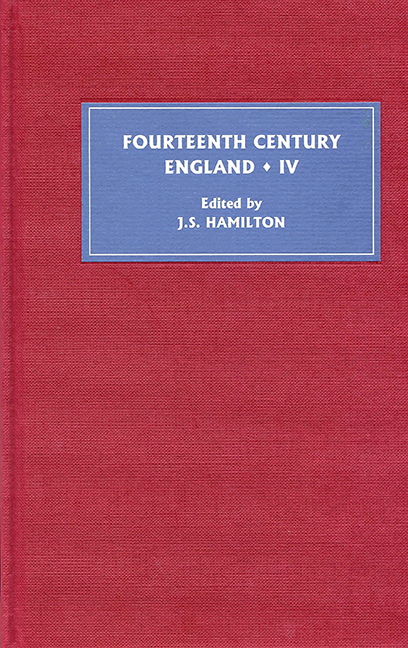Book contents
- Frontmatter
- Contents
- List of Illustrations
- Contributors
- Preface
- Abbreviations
- Who was St Thomas of Lancaster? New Manuscript Evidence
- ‘Hedging, Ditching and Other Improper Occupations’: Royal Landscapes and their Meaning under Edward II and Edward III
- Paying for the Wedding: Edward III as Fundraiser, 1332–3
- The Politics of Privilege: Thomas Hatfield and the Palatinate of Durham, 1345–81
- Agnes Maltravers (d. 1375) and her Husband John (d. 1364): Rebel Wives, Separate Lives, and Conjugal Visits in Later Medieval England
- Gendering Pastoral Care: John Mirk and his Instructions for Parish Priests
- Prosecution of the Statutes of Provisors and Premunire in the King's Bench, 1377–1394
- ‘Mercy and Truth Preserve the King’: Richard II's Use of the Royal Pardon in 1397 and 1398
- Aliens in the Pardons of Richard II
- ‘Too Flattering Sweet to be Substantial’? The Last Months of Thomas, Lord Despenser
- ‘O Prince, Desyre to be Honourable’: The Deposition of Richard II and Mirrors for Princes
- Regional Politics, Landed Society and the Coal Industry in North-East England, 1350–1430
Prosecution of the Statutes of Provisors and Premunire in the King's Bench, 1377–1394
Published online by Cambridge University Press: 12 September 2017
- Frontmatter
- Contents
- List of Illustrations
- Contributors
- Preface
- Abbreviations
- Who was St Thomas of Lancaster? New Manuscript Evidence
- ‘Hedging, Ditching and Other Improper Occupations’: Royal Landscapes and their Meaning under Edward II and Edward III
- Paying for the Wedding: Edward III as Fundraiser, 1332–3
- The Politics of Privilege: Thomas Hatfield and the Palatinate of Durham, 1345–81
- Agnes Maltravers (d. 1375) and her Husband John (d. 1364): Rebel Wives, Separate Lives, and Conjugal Visits in Later Medieval England
- Gendering Pastoral Care: John Mirk and his Instructions for Parish Priests
- Prosecution of the Statutes of Provisors and Premunire in the King's Bench, 1377–1394
- ‘Mercy and Truth Preserve the King’: Richard II's Use of the Royal Pardon in 1397 and 1398
- Aliens in the Pardons of Richard II
- ‘Too Flattering Sweet to be Substantial’? The Last Months of Thomas, Lord Despenser
- ‘O Prince, Desyre to be Honourable’: The Deposition of Richard II and Mirrors for Princes
- Regional Politics, Landed Society and the Coal Industry in North-East England, 1350–1430
Summary
In the early 1380s William Southam broke the windows, door and gate of Napton church in Warwickshire and assaulted the rector, Richard Tylhe, in order to disinter the body of Joan Radele who was buried within. Joan, a parishioner of Napton, had been laid to rest only twelve days before William exhumed her body, carried it outside the church, despoiled it, and then stole it. Why William sought such a gruesome revenge on Joan is unfortunately not known. This story is, nevertheless, recorded in the plea rolls of the king's bench during the reign of Richard II as a prosecution under the statute of premunire because it resulted in a dispute over which court system had jurisdiction over the crime. Should William be prosecuted in ecclesiastical court for sacrilege or in the king's court under a writ of vi et armis?
Richard Tylhe, the victimized rector, brought charges of sacrilege against Southam in the court of Rome. The court denounced and excommunicated William because his violence against the corpse of Joan was in ‘manifest contempt and sacrilege of Holy Mother Church’. William's excommunication was to endure until he returned Joan's body and paid restitution. William, angry that he had been forced to answer in an ecclesiastical court outside the realm of England, filed a suit of premunire against Richard Tylhe in the court of the king's bench during the Easter term of 1380, claiming £1,000 in damages. The statutes of premunire prohibited any Englishman from bringing suit in an ecclesiastical court if the cognizance, or jurisdiction, belonged to the king's courts. Southam claimed that this dispute, which had resulted in his excommunication, belonged instead in the king's courts. Southam pled via his attorney, John de Whatton, that this quarrel was not about sacrilege but instead about his breaking and entering with ‘force and arms’.
- Type
- Chapter
- Information
- Fourteenth Century England IV , pp. 109 - 123Publisher: Boydell & BrewerPrint publication year: 2006

